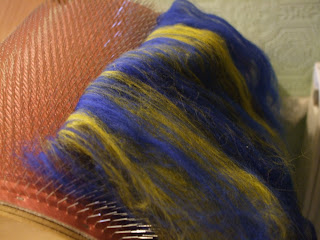 |
| photo by Elena Costella in her Perth shop/studio |
The photo was taken at the launch of Big Knitting at Elena Costella's Yarn and Fibre Studio in Perth click here last saturday. Elena is the only Scottish stockist for the Big Knitting and a crowd of knitters had a really fun afternoon trying out 3 sizes of Big needles, Big crochet hooks and even a Big circular needle. Ingrid Wagner, founder of the Big Knitting, click here was a colourful bundle of energy and inspiration.
The Italian connection
The 'yarn' in the photo is recycled selvedge from weaving blankets. The sharp-eyed among you may recognise the colours of the Italian flag in the yarn in my hand. I spotted it immediately as the selvedge from the blankets woven in Biella last year to celebrate the 150th anniversary of the unification of Italy. I was in Biella teaching a spinning course in November and bought one of the blankets. It is lovely and soft, the wool is produced locally by small-scale shepherds and all the processing is carried out within 10km.
Now I'm waiting impatiently to receive more of the selvedge/yarn so I can knit a pair of cushion covers to match my blanket.... on my new giant needles
in the meantime I've gone for a traditional red tartan 'selvedge' for the toning cushion
Almost instant gratification - the piece on the photo above is only 15 stitches and about 7 rows so far - mostly knitted by colleagues when I took the needles in to work yesterday to show some of the girls!.It makes a change from socks on 2mm pins!!
I'm planning all sorts of recycling projects, using old clothes and curtains - maybe a headboard, with the work still on the needles..... a quick way to make a big dent in the stash too...





























